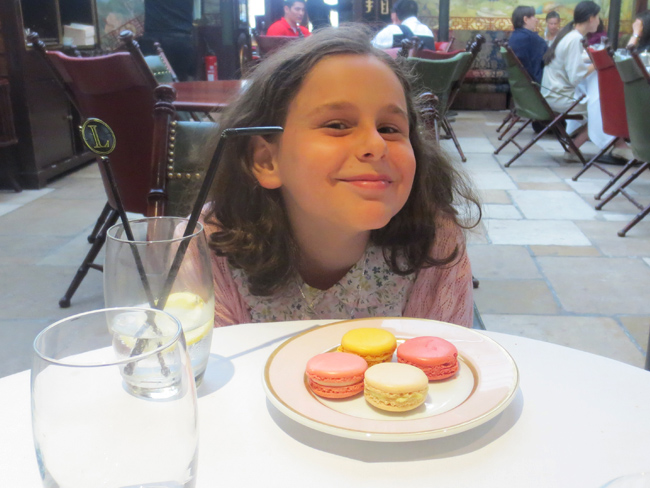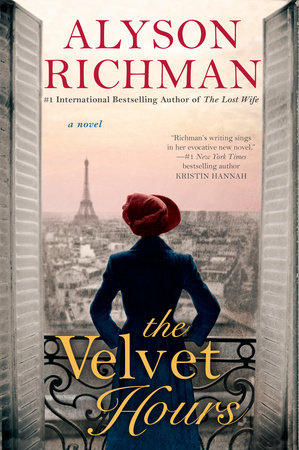La Vie en Rose: A Historical Novelist and Her Daughter Travel to Paris in the Name of Research
by Alyson Richman
Last summer, as I was nearing completion of my latest novel, The Velvet Hours, I needed one last trip to Paris to do some final fact checking. My daughter, Charlotte, reminded me that I had promised she could go to France with me when she turned nine. When I had made that agreement a few years earlier, nine seemed so far away. But now she was holding me to my word.
My daughter has always had a fascination with art. My mother was an abstract painter in her early twenties, and before I became a novelist, I aspired to become an artist myself. Early on in my research for The Velvet Hours, Charlotte showed me an image of the Peacock Room, which she had seen on a video at the Freer Gallery in Washington D.C. She thought it looked like the photographs taken of the sumptuous Parisian apartment of Marthe de Florian, which had inspired my novel. When I studied the Peacock Room, with its Asian porcelains and a magnificent portrait by artist James Whistler in a gilded frame, I immediately saw why she had noticed similarities. Madame de Florian’s apartment, which had been mysteriously shuttered for seventy years, contained shelves of antiques, Asian ceramics, and a beautiful portrait of her in her youth by Giovanni Boldini, also in an ornate gold frame. Because Charlotte had given me a point of reference to try and bring Madame de Florian’s apartment back to life, I felt compelled to make her wish to go to Paris come true.
In preparation for our trip, Charlotte devoured Charlotte in Paris by Joan MacPhail Knight and was delighted to find a book in which she shared a name with the main character. This story, written in diary form, chronicles the adventures of a young girl in the City of Light. She also borrowed several of the Nicholas books by René Goscinny from her older brother’s bookshelf, which also take place in Paris.
I had several factual items for my novel that I needed to verify on my trip. The majority of my research had been done the year before when I visited Paris by myself. But on this trip, Charlotte and I would walk the streets that bordered Marthe de Florian’s fabled apartment on the Square Bruyère. We’d chart the path from the apartment to Boldini’s studio on Boulevard Berthier, as well as visit the bookshops in the Marais that play a prominent role in my book.
Before we left, I spoke with one of my dear friends and fellow novelist, M.J. Rose, who has traveled to Paris many times and knows the city incredibly well. Luckily, she had just come back from her own research trip for her sumptuous historical novel, The Secret Language of Stones. Excited to share her knowledge with me, M.J. outlined a walking itinerary for Charlotte and me that began with purchasing a single rose avec parfum (one with a strong fragrance) at Costes, the elegant florist in the hotel by the same name on the Rue Saint Honoré. This was such a beautiful way to start our first afternoon in Paris together. The pretty florist picked out three tall stemmed flowers in different stages of budding and asked Charlotte to select one. The memory of her bending down and inhaling the intoxicating fragrance from each rose is one I will always cherish. Charlotte picked a beautiful deep pink rose with a few open petals and then the florist went swiftly to work at trimming the leaves and removing the thorns, before wrapping the single bloom in layers of hot pink tissue paper and tying it with a beautiful satin ribbon. Charlotte exited the shop with the biggest smile on her face and carried the rose through the rest of the afternoon, often dipping her nose into the petals in order to savor their scent.
That day, we walked for hours, mapping the footsteps of my two central characters, Marthe and her granddaughter, Solange. We found inspiration in the small antique shops across the Seine and then took a break in Laudrée on the corner of Rue Bonaparte, where Charlotte learned to order her three favorite macaroon flavors in French: Framboise, Citron, and Cassis (Raspberry, Lemon, and Blackcurrant).

Later on we dipped into Sennelier, one of the oldest and longest-running art supply stores in Paris. Picasso, Cezanne, and many others artists bought their brushes and paint in this colorful shop near the Seine. I mused with Charlotte that perhaps Giovanni Boldini had also purchased his art supplies in this shop over a hundred years before. Hoping to be connected to a bit of history, I purchased a small sketchbook and set of drawing pencils for Charlotte to take with her on the rest of our trip.

Charlotte carried her sketchbook and pencils everywhere. We walked through the galleries in the Musée D’Orsay, where she fell in love with the Impressionist paintings on display, and soon found a spot near the marble sculptures, where she began to sketch.
The next afternoon we hired a car and travelled to Giverny to visit Monet’s house and gardens. I wanted Charlotte to see his studio and residence before she experienced his amazing water lilies on display at the Musée de l’Orangerie. M.J. Rose had told me about Musée Marmottan, a little known museum in the 16th Arrondisement of Paris that contained the private collection of Monet’s paintings. Since this was another neighborhood in Paris that was featured in my novel, I knew we could coordinate another bit of research after we visited it.

Once inside, we both marveled at the paintings of flowers that we had seen in Monet’s garden. Large panels of roping vines of wisteria and smaller works of irises and field flowers brought back lovely memories from the day before.
That evening, when we tucked into scoops of Berthillon ice cream after listening to a string quartet perform Vivaldi in the beautiful stained glass venue of Saint Chapelle, I asked Charlotte if Paris was all she dreamed it would be. With a smile beaming from her face, her response was simple: “Even better, Mommy!”

